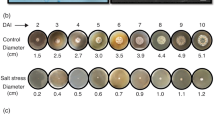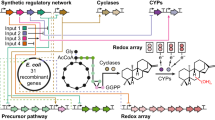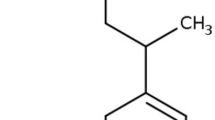Abstract
Pyripyropenes are potent inhibitors of acyl-CoA:cholesterol acyltransferase, which were initially discovered to be produced by Aspergillus fumigatus. Recently, Penicillium coprobium PF1169 has also found to produce pyripyropene A (PyA), which exhibits insecticidal properties. Pyripyropenes are natural hybrid products of both terpenoid and polyketide origin. In our research, based on data generated using the Genome Sequencer FLX for P. coprobium PF1169, we predicted the biosynthetic gene cluster of PyA by blast analysis comparing with polyketide synthase and prenyltransferase of other species. By screening the genomic fosmid library, nine open reading frames (ppb1 to ppb9) related to the biosynthesis of PyA were deduced. Among them, two cytochrome P450 monooxygenase genes (ppb3 and ppb4) were separately introduced into the model fungus A. oryzae. Bioconversion of certain predicted intermediates in the transformants has elucidated the manner of hydroxylation in the biosynthetic pathway by the expressed products of these two genes (P450-1 and P450-2). That is, P450-1 exhibits monooxygenase activity and plays the hydroxylation role at C-11 of pyripyropene E. While P450-2 plays an active role in the hydroxylation of C-7 and C-13 of pyripyropene O.
Similar content being viewed by others
Log in or create a free account to read this content
Gain free access to this article, as well as selected content from this journal and more on nature.com
or
References
Tsujiuchi, G., Nakahashi, M., Yamamoto, D., Tani, M. & Takagi, M. Novel microorganism having ability to produce pyripyropenes. J. Tech. Disclosure. 2008-500997, 2 (2008).
Wang, H. J., Gloer, J. B., Wicklow, D. T. & Dowd, P. F. Aflavinines and other antiinsectan metabolites from the ascostromata of Eupenicillium crustaceum and related species. Appl. Environ. Microbiol. 61, 4429–4435 (1995).
Ōmura, S., Tomoda, H., Kim, Y. K. & Nishida, H. Pyripyropenes, highly potent inhibitiors of Acyl-CoA:Cholesterol acyltransferase produced by Aspergillus fumigatus. J. Antibiot. 46, 1168–1169 (1993).
Hayashi, A., Arai, M., Fujita, M. & Kobayshi, M. Pyripyropenes, fungal sesquiterpenes conjugated with α-pyrone and pyridine moieties, exhibits anti-angiogenic activity against human umbilical vein endothelial cells. Biol. Pharm. Bull. 32, 1261–1265 (2009).
Tomoda, H. et al. Biosynthesis of pyripyropene A. J. Org. Chem. 61, 882–886 (1996).
René De, M. O. T. & Annabel, H.A.Parret. A novel class of self-sufficient cytochrome P450 monooxygenases in prokaryotes. Trends microbial 10–11, 502–508 (2002).
Estabrook, R. W. Cytochrome P450 and Oxygenation Reactions: a Status Report. in Drug Metabolism and Drug Toxicity (eds Mitchell J.R. & Horning M.G.) 1–20 (Raven Press, New York, 1984).
Nelson, D. R. et al. The P450 superfamily: update on new sequences, gen mapping, accession numbers, early trivial names of enzymes, and nomenclature DNA. Cell Biol. 12, 1–51 (1993).
Kotze, A. C. Cytochrome P450 monooxygenase activity in Haemonchus contortus (Nematoda). Int. J. Parasitol. 27-1, 33–40 (1997).
Yamada, O. et al. dffA gene from Aspergillus oryzae encodes L-ornithine N5-oxygenase and is indispensable for deferriferrichrysin biosynthesis. J. Biosci. Bioeng. 95, 82–88 (2003).
Gomi, K., Iimura, Y. & Hara, S. Integrative transformation of Aspergillus oryzae with a plasmid containing the Aspergillus nidulans argB gene. Agric. Biol. Chem. 51, 2549–2555 (1987).
Turina, M., Prodi, A. & Van Alfen, N. K. Role of the Mfl-1 pheromone precursor gene of the filamentous ascomycete Cryphonectria parasitica. Fungal Genet. Biol. 40, 242–251 (2004).
Cox, R. J. Polyketides, proteins and genes in fungi: programmed nano-machines begin to reveal their secrets. Org. Biomol. Chem. 5, 2010–2026 (2007).
Varga, J., Rigó, K., Kocsube, S., Farkas, B. & Pál, K. Diversity of polyketide synthase gene sequences in Aspergillus species. Res. Microbiol. 154, 593–600 (2003).
Schmitt, I., Kautz, S. & Lumbsch, H. T. 6-MSAS-like polyketide synthase genes occur in lichenized ascomycetes. Mycol. Res. 112, 289–296 (2008).
Nicholson, T. P. et al. Design and utility of oligonucleotide gene probes for fungal polyketide synthases. Chem. Bio. 8, 157–178 (2001).
Marco, A.V.S.B., Ilja, W., Chris, L., Richard, K. & Roel, A. L. B. Functional characterization of the penicillin biosynthetic gene cluster of Penicillium chrysogenum Wisconsin54-1255. Fung. Gene. Biol. 44, 830–844 (2007).
Karolewiez, A. & Geisen, R. Cloning a part of the ochratoxin A biosynthetic gene cluster of Penicillium nordicum and characterization of the ochratoxin polyketide synthase gene. Syst. Appl. Microbiol. 28, 588–595 (2005).
Ito, T. et al. O-14, Abstract of paper of 17th Symposium on the Development and Application of Naturally Occurring Drug Materials, Kyushu Univ., Japan (2008).
Ito, T. et al. Biosynthetic study of meroterpenoids from filamentous fungi (3)-Functional analysis of enzymes involved in cyclization of terpenoid moiety in the biosynthesis of pyripyropene A. 27G-pm04, Abstract of paper of 129th anniversary conference of the pharmaceutical society of Japan, Kyoto, Japan (2009).
Itoh, T. et al. Reconsititution of a fungal meroterpenoid biosynthesis reveals the involvement of a novel family of terpene cyclases. Nat. Chem. 2, 858–864 (2010).
Kim, Y. K. et al. Pyripyropenes, novel inhibitors of acyl-CoA:cholesterol acyltransferase produced by Aspergillus fumigatus. II. Structure elucidation of pyripyropenes A, B, C and D. J. Antibiot. 47, 154–162 (1994).
Obata, R., Sunazuka, T., Tomada, H., Harigaya, Y. & Ōmura, S. Chemical modification and structure-activity relationships of pyripyropenes; potent, bioavailable inhibitor of acyl-CoA: cholesterol O-acyltransferase (ACAT). Bioorg. Med. Chem. Lett. 5-22, 2683–2688 (1995).
Nakagawa, A. & Ōmura, S. Biosynthesis of bioactive microbial metabolites and its application to the structural studies and production of hybrid compounds. J. Antibiot. 49-8, 717–741 (1996).
Amos, B. S. & Takeshi, K. Biomimetic total synthesis of the ACAT inhibitor (+)-pyripyropene E. Tetrahedron Lett. 37-36, 6461–6464 (1996).
Kira, I. & Onishi, N. Purification and characterization of a (R)-1-phenyl-1,3-propanediol-producing enzyme from Trichosporon fermentns AJ-5152 and enzymatic (R)-1-phenyl-1,3-propanediol production. Biosci. Biotechnol. Biochem. 73, 1640–1646 (2009).
Acknowledgements
We wish to express our thanks to Hakutsuru Sake Brewing company for providing the A. oryzae HL-1105 and HL-1034. We also wish to thank Dr Yamada of the National Research Institute of Brewing for providing the plasmid vector pUSA; Dr Yamashita for the documents on transformation; Ms Tsuchida for providing assistance in our LC-MS and LC-NMR analysis; and Dr Pam Kazmierczak and Dr Furutani for reviewing this paper.
Author information
Authors and Affiliations
Corresponding author
Additional information
Supplementary Information accompanies the paper on The Journal of Antibiotics website
Supplementary information
Rights and permissions
About this article
Cite this article
Hu, J., Okawa, H., Yamamoto, K. et al. Characterization of two cytochrome P450 monooxygenase genes of the pyripyropene biosynthetic gene cluster from Penicillium coprobium. J Antibiot 64, 221–227 (2011). https://doi.org/10.1038/ja.2010.162
Received:
Revised:
Accepted:
Published:
Issue date:
DOI: https://doi.org/10.1038/ja.2010.162
Keywords
This article is cited by
-
The Biogenetic Origin of the Biologically Active Naematolin of Hypholoma Species Involves an Unusual Sesquiterpene Synthase
Molecular Biotechnology (2019)
-
Penicillium arizonense, a new, genome sequenced fungal species, reveals a high chemical diversity in secreted metabolites
Scientific Reports (2016)
-
Phenylpyropenes E and F: new meroterpenes from the marine-derived fungus Penicillium concentricum ZLQ-69
The Journal of Antibiotics (2015)



